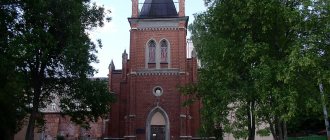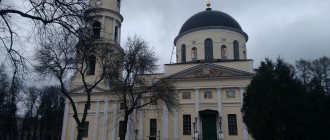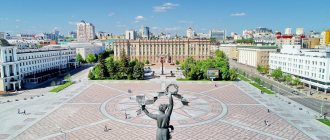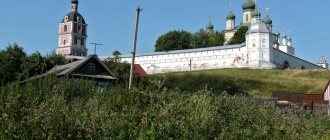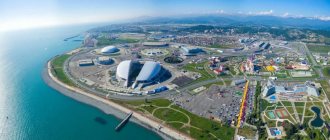Polotsk, the oldest city of White Rus', is located in the geographical center of Europe. It has stood for more than a millennium at the confluence of the Western Dvina and Polot rivers. The history of modern Belarus began with him.
The townspeople treat their famous city with care and love. They approach the placement of exhibitions in a variety of buildings with extraordinary creativity. They find new topics, place unusual accents when looking at their history, turning Polotsk into a museum city.
Hundreds of thousands of tourists and pilgrims come to this quiet provincial town every year: to see the reflection of an elegant basilica in the quiet waters of the river, listen to a concert in an ancient temple, look into the water tower, see the museum-reserve and the museum of one street.
What you can visit around Polotsk or on the way here from other cities of Belarus - lakes, nature reserves, memorials and museums in an overview of the main places in the country.
Brief information about Polotsk
Polotsk is located in the Vitebsk region of the Republic of Belarus. It occupies an area of about 40 km2 and has a population of more than 80 thousand people. It is considered the oldest city in the country - the first mention of it in ancient chronicles dates back to 862.
A little history of Polotsk
Modern archaeological excavations on the territory of the city have shown that already in 780 this area was inhabited by the Krivichs (East Slavic tribes engaged in agriculture, cattle breeding and crafts). There was a fortified settlement with an area of 2 hectares and a height of 13.5 m. At the foot of the fortress there was a developed system of residential settlements.
In the 10th century, the Principality of Polotsk was formed, which over the next three centuries was a strong and independent state. In those days, Polotsk was considered the economic, cultural and religious center of Eastern Europe. Majestic temples were erected here, libraries were built, and trade developed. At the end of the 13th century, the Polotsk lands gradually lost their independence: Lithuanians increasingly found themselves on the princely throne. At the end of the 14th century, Polotsk became part of the Grand Duchy of Lithuania, and at the end of the 16th century - part of the Polish-Lithuanian Commonwealth.
Ancient Polotsk was first mentioned in the Tale of Bygone Years in 862
In 1772, Polotsk became part of the Russian Empire, as well as the administrative center of the Polotsk province. This contributed to the development of the economy and culture, and the city regained its status as an important trading center in Europe.
At the beginning of the 19th century, large public postal routes passed through Polotsk - Riga, Vitebsk, Mogilev, as well as significant merchant routes - Vilensky, Lepelsky, Disnensky. During the First Patriotic War, the city was captured by French troops. After two bloody battles with the French, the Russian army liberates the city.
In 1924, Soviet power came to Polotsk, the city became part of the BSSR. On July 16, 1941, Polotsk was occupied by German troops. The liberation of the city took place on July 4, 1944.
Polotsk University in the building of the Jesuit College
The Collegium was founded in 1580 by decree of Stefan Batory, king of the Polish-Lithuanian Commonwealth. It was transformed into a Jesuit academy in 1812. Now the building of the collegium houses Polotsk State University.
The clock was installed in 2011, as evidenced by the inscription in Latin
How to get to the city
You can get to Polotsk using the following types of transport:
- train: from Moscow to Polotsk departs from the Belorussky railway station;
- from St. Petersburg - from Vitebsky station;
- Polotsk station also receives trains from Gomel, Mogilev, Vitebsk, Riga and Kaliningrad;
Polotsk railway station receives trains from Moscow, St. Petersburg, Gomel, Mogilev, Vitebsk, Riga and Kaliningrad
- a direct flight from Moscow to Polotsk is operated by the carrier “IP Kadzhaya A.A.”, the landing place is the “Novoyasenevskaya” bus station;
- the route from Moscow to Polotsk leads along the M1 highway to Smolensk, then A141 to Vitebsk, after that A215 to Polotsk;
Red Bridge
The landmark of the time close to us - the Red Bridge, will make you remember the Patriotic War of 1812. Once wooden, this bridge was drenched in blood during the war, which is why it got its frightening name. In the middle of the 20th century, the bridge became reinforced concrete, but retained the memory of its history in the form of a plaque dedicated to the soldiers-liberators of the Belarusian land.
If you are walking around the city, be sure to walk along Nizhnepokrovskaya Street - this is a favorite walking place for local residents, it can be called central and there are many architectural monuments on it. Many of the attractions mentioned here belong to her.
Sights of Polotsk
There are few entertainment facilities in Polotsk. There are no theaters, large restaurants, or water parks here. Despite this, more than 300 thousand tourists and pilgrims visit Polotsk every year. What makes a city attractive is not its expensive and noisy establishments, but its architectural and historical masterpieces.
The tourist map shows the main attractions of Polotsk
Churches and other religious shrines
First of all, the city is known for its churches, where great Orthodox shrines are kept. Many of the city's churches are not only places of prayer, but also ancient monuments. The St. Sophia Cathedral and the Spaso-Euphrosinievsky Monastery deserve special attention.
Saint Sophia Cathedral
Practical information:
- address - st. Zamkovaya, 1;
- opening hours: from 10.00 to 17.00, closed on Monday;
- cost of tickets to the Museum of the History of St. Sophia Cathedral: 5 Belarusian rubles (BYN) adult;
- 2.5 Belarusian rubles preferential.
St. Sophia Cathedral in Polotsk appeared later than its sisters of the same name in Kyiv and Novgorod. All three churches of Hagia Sophia were created in the image of the cathedral in Constantinople. Construction of the temple began in 1044 and ended only 22 years later. The cathedral was erected by Byzantine craftsmen, as well as by residents of Polotsk. When creating the church, plinth was used - a flat brick, which was made according to a secret recipe. St. Sophia Cathedral was the first building made of stone on Belarusian lands. The temple was not only the center of the spiritual life of the Orthodox, but also played a cultural and educational role: a huge library, treasury and magistrate were located here, and receptions were also held for ambassadors.
Translated from Greek, “sophia” means “wisdom”.
Over its centuries-old history, the temple was destroyed and restored several times. The church received its modern image in the 18th century, when, according to the design of Jan Glaubitz, a majestic basilica appeared on the banks of the Dvina. The interior was decorated with elements of stucco and painting, carved cornices, and bas-relief images. From the 11th century cathedral, only the foundation, the lower parts of the walls and supporting pillars remain.
St. Sophia Cathedral - the main shrine of Polotsk
In ancient times, there was a princely tomb in the St. Sophia Cathedral. During modern archaeological excavations, 16 sarcophagi were discovered.
Currently, St. Sophia Cathedral is not only one of the greatest churches in Belarus, but also the historical and cultural center of the country. In 1987, the Museum of the History of St. Sophia Cathedral was opened, where you can see fragments of ancient masonry and foundation, as well as frescoes from the late 9th century. The exhibition is located inside the St. Sophia Cathedral and occupies an area of 870 m2. A concert hall has also been created on the territory of the temple, where festivals of chamber and organ music are held annually. Such famous organists as Johann Trummer and Pierre Zhivo performed in the St. Sophia Cathedral.
Borisov stone
Near the entrance to St. Sophia Cathedral there is a Polotsk Boris stone, which was previously located in the Western Dvina basin at a distance of 5 km from the city.
Borisov stones are huge boulders on which crosses are carved, as well as the inscription “Lord, help your servant Boris.” Historians suggest that these inscriptions were made on the orders of Prince Boris Davydovich, who ruled the Polotsk lands at the beginning of the 12th century.
As a result of the natural weathering of feldspar, the surface of the Borisov stone in Polotsk is grainy and uneven, the inscription and cross are barely visible.
In 1889, the first attempt to pull the stone out of the water took place, but it ended unsuccessfully. And only a hundred years later the stone was able to be moved to the shore and delivered to Polotsk. The boulder has a reddish color and irregular shape, the length in diameter is 3 m. A cross is carved on the stone and an inscription traditional for Boris stones is made.
People say that if you walk around a stone three times and make a wish, it will certainly come true.
Spaso-Euphrosinievsky Monastery
Practical information:
- address - st. Euphrosyne of Polotsk, 89;
- The monastery’s tour desk is open daily from 9.00 to 17.00;
- travel - from Polotsk bus or railway stations by bus No. 4 to the Lesnoy Tekhnikum stop.
Spaso-Evfrosinievsky Monastery is a sacred place with mystical energy and an amazing atmosphere. This is a grandiose religious complex, on the territory of which there are not only churches, but also two libraries, workshops for making icons and candles, and a church shop. Pilgrims constantly come here to venerate Orthodox shrines.
On the territory of the modern Spaso-Efrosinyevsky Monastery in Polotsk there are temples, libraries and other buildings
Founded by Euphrosyne of Polotsk, a famous Orthodox saint.
Euphrosyne was a princess by birth, and a brilliant secular future awaited her. However, upon reaching adulthood (age 12), Euphrosyne decided to abandon worldly joys. Having secretly escaped from her father's house, she took monastic vows in one of the Polotsk monasteries, where her own aunt was the abbess. In the monastery, Euphrosyne copied and translated books, and carried out peacekeeping and educational activities. At the end of her life, she went to Jerusalem, where she died in 1167. She was buried on Jerusalem soil in the monastery of St. Theodosius. At the beginning of the 20th century, part of the relics of the princess was transported to the Spaso-Euphrosinievsky Monastery.
Euphrosyne of Polotsk - princess, nun, Orthodox saint
It was no coincidence that the princess made the decision to create a new convent. Legend tells that Bishop Ilya of Polotsk saw a prophetic dream in which an angel commanded the nun Euphrosyne to found a holy monastery in these lands. The princess herself had a similar dream. So in 1125, thanks to the efforts of Euphrosyne, the construction of a monastery began in Polotsk.
originally built - the only cultural monument of the Polotsk land that has been completely preserved to this day. The church was created in a short time - in 30 weeks. The temple was erected under the leadership of the talented architect John, who, before construction began, every morning at dawn he heard a voice commanding him: “O John, get up and go to the work of the Almighty Savior.”
The temple has two tiers. On the top floor there are choirs, on either side of which there are two tiny cells. In one of them Euphrosyne spent days and nights in prayer. The church has very modest dimensions: the length is 14 m, the width is less than 10 m. The peculiarity of the architecture of the temple is verticalism (the church is directed upward).
A feature of the architecture of the Transfiguration Church in Polotsk is verticalism
Euphrosyne of Polotsk donated an altar cross made by skilled jeweler Lazar Bogsha to the Transfiguration Church. The Euphrosyne Cross was an ark, inside which Orthodox shrines were kept: a particle of the Tree of the Holy Cross, particles of stones of the Holy Sepulcher and the Sepulcher of the Mother of God, particles of the relics of various saints. The outside of the Cross was decorated with precious stones, pearls, and icons; on the sides there was an inscription - the will of Euphrosyne of Polotsk, which stated the prohibition of removing the Cross from the Transfiguration Church. However, this will was not destined to come true: the Cross of Euphrosyne was taken to Smolensk during the internecine wars. At the end of the 16th century, the shrine was returned to the Spaso-Euphrosinievsky Monastery. After the arrival of Soviet power in Polotsk, the Cross was transported to Minsk, then to Mogilev, and during the Great Patriotic War it disappeared without a trace. In the middle of the 20th century, photographic negatives of the Euphrosyne Cross on glass were found in the Leningrad branch of the Institute of Archeology. In the 90s of the last century, work began on recreating the Orthodox relic. For this purpose, shrines were collected for the new cross. The copy of the Cross itself was made by the artist-jeweler N.P. Kuzmin. In 1997, the recreated Cross was brought into the Transfiguration Church, where it is kept in the altar to this day.
The recreated Cross of Euphrosyne of Polotsk - the main shrine of the Transfiguration Church in Polotsk - repeats in the smallest detail the image of the lost masterpiece.
Also on the territory of the Spaso-Euphrosyne Monastery is the Exaltation of the Cross Cathedral, built in 1897 according to the design of Vitebsk architect V. F. Korshikov. The building is made of white stone and has a cruciform shape. The Cathedral of the Exaltation of the Cross is crowned with 5 helmet-shaped domes with gilded crosses. The cathedral has two chapels:
- the right side chapel is consecrated in honor of the Smolensk Mother of God,
- the left side aisle is in honor of St. Nicholas the Wonderworker.
The Exaltation of the Cross Cathedral in Polotsk is made in the Russian-Byzantine style
The Cathedral of the Exaltation of the Cross contains great Orthodox shrines: part of the relics of Euphrosyne of Polotsk, the miraculous icons of the Mother of God - Ephesus and Krasnostok.
In 1842, a house church was built in the monastery house, which was consecrated in honor of Euphrosyne of Polotsk. The temple was a large room located near the nuns' cells. After 5 years, the house church was rebuilt into a stone church. In 1886, the church was increased in size: the ceiling was raised, the walls were built on.
The beginning of the 20th century became a period of devastation for the monastery: with the advent of Soviet power, the temple was closed and transferred to the disposal of the military department. During the Great Patriotic War, the church building suffered a lot of damage and fell into final disrepair. And only in 1989 a major renovation was carried out in the temple.
St. Euphrosyne Church in Polotsk is a snow-white stone structure where statutory services are held
Currently, statutory services are held in the St. Euphrosyne Church, and Divine Liturgy is held on church holidays and on Sundays.
Inside the St. Euphrosyne Church there are Orthodox shrines: the icons of the Mother of God “Iverskaya” and “Vsetsaritsa”, an ark with a particle of the holy relics of Euphrosyne of Polotsk.
Museums of Polotsk
There are more than a dozen museums in Polotsk, and each of them is fascinating and interesting in its own way.
Polotsk Museum of Local Lore
Practical information:
- address - st. Nizhne-Pokrovskaya, 11;
- Opening hours: Tuesday to Sunday from 10.00 to 18.00;
- ticket price: adults - 4 Belarusian rubles;
- children - 2 Belarusian rubles;
The museum is located in the building of a former Lutheran church built in the 19th century. The exhibition covers an area of 550 m2 and includes more than 2 thousand exhibits. The archaeological finds of greatest interest are:
- silicon knives,
- arrows,
- scrapers,
- mammoth bones.
The ethnographic exhibition telling about peasant life is also fascinating. Displayed here:
- national clothes, shoes,
- everyday utensils.
The collection dedicated to the War of 1812 also takes pride of place in the museum. Collection items:
- military uniforms,
- weapon,
- portraits of commanders.
The Polotsk Museum of Local Lore is located in the building of a former Lutheran church, which is an architectural monument of the 19th century.
Natural and Ecological Museum
Practical information:
- address - st. Skorina, 21;
- opening hours: from 10.00 to 18.00, closed on Monday;
- ticket price: adults - 4 Belarusian rubles;
- children - 2 Belarusian rubles.
The museum was founded in 2006 in the premises of a former water tower. The exhibition is located on 4 floors. You can climb to the upper levels of the museum via an ancient spiral staircase located in the center of the building. A tour of the museum’s five aquariums will help you take a break from everyday worries and also enjoy the beauty of the underwater world. In one of them, near the underwater castle of the little mermaids, a flock of barbs lives, in another, cichlids slowly swim above a sunken ship, in the remaining aquariums you can see angelfish, metinnis and other amazing fish.
The aquariums of the Natural Ecological Museum in Polotsk are home to various species of fish, including angelfish
And also in the museum you can get acquainted with information about rare species of animals and birds living in Belarus. A playful version of visiting the exhibition has been developed especially for children - the guide “Kaleidoscope of Mysteries and Discoveries.” Children who complete all tasks in the guide are awarded with memorable gifts.
Museum of Medieval Knighthood
Practical information:
- address - st. Engelsa, 3;
- Opening hours: Thursday to Sunday from 10.00 to 17.00, break from 12.00 to 13.00;
- travel by bus number 4.
When visiting this museum you will get acquainted with the history of the development of knighthood in the Polotsk lands. Museum exhibits:
- interiors of ancient castles;
- Knight armour;
- ancient weapons - bows, arrows, crossbows.
The exhibition is located in three halls. There is no guide in the museum; all useful information is recorded on a disk, which is turned on for visitors to the exhibition. It is interesting that the museum collection was collected not by historians or archaeologists, but by a private individual - a descendant of the noble Rurik family.
In the Museum of Medieval Chivalry in Polotsk you can see equipment and weapons that were used by warriors in ancient times
After the sightseeing tour, visit the souvenir shop in the museum, where they sell figurines, chests, magnets and other interesting items.
Art Gallery
Practical information:
- address - st. Streletskaya, 4;
- Opening hours: Tuesday to Sunday from 10.00 to 17.00;
- ticket price: adults - 5 Belarusian rubles;
- children - 2.5 Belarusian rubles;
The art gallery is located in the building of the former Jesuit college. The museum occupies an area of 900 m2 and is housed in two exhibition halls. Exhibits:
- icons of the 18th–19th centuries;
- collections of iconic 19th-century copper castings;
- secular portraits of the 18th–19th centuries;
- objects of applied art.
In the Art Gallery of Polotsk you can see ancient paintings and icons.
In 2014, the museum opened an exhibition showing murals from the 17th–19th centuries of the Transfiguration Church. This became possible thanks to many years of work by scientists and restorers.
In the Art Gallery of Polotsk you can see elements of the ancient murals of the Transfiguration Church
The museum also often hosts exhibitions of contemporary Belarusian and foreign artists.
An urban legend says that the ghost of Gabriel Gruber, who during his lifetime was a general of the Jesuit Order, as well as a talented mechanic and physician, “walks” through the art gallery at night. Gabriel Gruber was fond of alchemy and died under mysterious circumstances. The general’s ghost is “good” and does not harm anyone. The only thing is that it is very noisy: at night it misbehaves and drops pictures.
Museum of Belarusian Printing
Practical information:
- address - st. Nizhne-Pokrovskaya, 22;
- Opening hours: throughout the year - daily from 10:00 to 17:00, closed on Mondays;
- in summer - daily from 10:00 to 18:00, closed on Monday;
- adults - 5 Belarusian rubles;
The museum is located in the building of a former architectural monument of the 18th century - the Brotherhood School of the Polotsk Epiphany Monastery. The exhibition introduces tourists to the history of the creation of writing. In the museum you can see:
- writing instruments,
- handwritten books,
- old printed as well as modern publications,
- magazines and newspapers from different years,
- antique printing products.
In the Museum of Belarusian Printing in Polotsk you can see ancient writing instruments
City monuments
In Polotsk there is something to see for those tourists who are not attracted to museums, as well as monasteries and religious sites. In good weather, it is pleasant to walk around the beautiful city and see various monuments.
Memorial sign “Polotsk - the geographical center of Europe”
Practical information:
- address: Francysk Skaryna Avenue;
- how to get there - from the train station by car or on foot (15 minutes) across Gogol Street.
The sign was installed in 2008 on City Day, by architect Ivan Borovik and sculptor Alexander Prokhorov.
Belarusian geodesists, using aerospace photography, established the exact coordinates of the geographical center of Europe - 55°30' north latitude and 28°48' east longitude (calculations were confirmed by the Central Research Institute of Geodesy, Aerial Photography and Cartography in Moscow). He ended up in the ancient city of Polotsk, and a memorial sign in the form of a hemisphere with a map of Europe was placed in the park. The symbol of Polotsk rises above the hemisphere - a golden boat and four arrows pointing to the cardinal directions.
At the top of the memorial sign “Polotsk - the geographical center of Europe” there is a golden boat - a symbol of the city
Monument to the letter "Ў"
Practical information:
- address: Francis Skaryna Avenue;
- how to get there - from the train station by car or on foot (16 minutes) across Gogol Street.
In 2003, during the celebration of the Day of Belarusian Literature, a monument to the letter “Ў” was erected in Polotsk. The author is Polotsk artist Igor Kurzhalov. This unique letter (there is no such letter in any alphabet in the world) is a symbol of the Belarusian alphabet. The sound designated U short is quite common in Belarusian speech; it gives softness and melody to the dialect of the inhabitants of this republic.
The letter "Ў" is a symbol of the Belarusian alphabet
Mound of Immortality
Practical information:
- address - st. Mound of Immortality, 1;
- Opening hours: from June 1 to August 31, daily except Mondays, from 10:00 to 18:00.
The mound was poured by city residents in memory of fellow citizens who died during the Great Patriotic War in 1966. During its construction, they added the ashes of burned villages, earth from battle sites and mass graves. The project was prepared by the chief architect of Polotsk N.P. Glazunov. The height of the memorial is 10 m, it contains 2.5 thousand m3 of earth.
The height of the Mound of Immortality in Polotsk is 10 m
Red Bridge
Practical information:
- address - st. Euphrosyne of Polotsk;
- how to get there - from the railway station by car or on foot (16 minutes) through Oktyabrskaya and Efrosinia Polotskaya streets.
This bridge over the Polota River is named after the bloody battle between the Russians and the French during the War of 1812. During the fierce battle, the wooden deck of the bridge turned red from the spilled blood. In 1975, instead of the old wooden one, a reinforced concrete bridge was built, the fences of which are decorated with memorial signs.
The Red Bridge in Polotsk is named after the bloody battle between the Russians and the French during the War of 1812
Monument to the heroes of the Patriotic War of 1812
Practical information:
- address - Freedom Square;
- how to get there - from the railway station by car or on foot (19 minutes) through Gogol Street and Francis Skaryna Avenue.
In the center of Freedom Square is the Monument to the Heroes of the Patriotic War of 1812. The monument originally appeared on this site in 1850, and the heir to the Russian throne, Alexander Nikolaevich, was present at the opening ceremony. However, in the 30s of the last century, the monument was demolished and a monument to Lenin was erected in its place. And only in 2010 the Monument to the Heroes of the Patriotic War of 1812 was installed on the square again.
In the center of Freedom Square in Polotsk stands the Monument to the Heroes of the Patriotic War of 1812
On both sides of the monument there are cannons from which shots were fired during the events of 1812.
On Freedom Square in Polotsk there are two cannons from the Patriotic War of 1812
Monument to the liberators of Polotsk
Practical information:
- address - Freedom Square;
- how to get there - from the railway station by car or on foot (19 minutes) through Gogol Street and Francis Skaryna Avenue.
Another monument was erected on Freedom Square - to the liberators of Polotsk. Thus, the feat of the Red Army soldiers of the 1st Baltic Front, who liberated Polotsk from the fascist invaders, was immortalized in stone and metal.
A monument to the liberators of Polotsk during the Great Patriotic War was erected on Freedom Square
Yuri Vizbor’s song “The Price of Life” is dedicated to this feat:
This city is called Polotsk,
It is split into two parts by war,
It is split into two parts by the river,
Full of quiet forest peace...
Monument to Prince Vseslav the Magician
- address: Euphrosyne Polotskaya Street; Practical information:
- how to get there - from the railway station by car or on foot (11 minutes) across Oktyabrskaya Street.
At the intersection of Oktyabrskaya and Euphrosyne Polotskaya streets there is a monument to Prince Vseslav the Magician. The statue was created by the talented sculptor Alexander Prokhorov. The prince is depicted on a galloping horse, with a falcon flying nearby. The monument is cast from bronze, the height of the statue is 3.5 m. An interesting fact is that the monument was created not at the expense of budget money, but with funds raised by the townspeople.
The monument depicts Vseslav the Magician, the famous Polotsk prince
The name of Vseslav the Sorcerer is shrouded in secrets and legends. The chronicles tell that his mother gave birth to him “by magic.” The newborn prince had a birthmark on his head - a consequence of witchcraft. The sages of that time advised the princess to cover the child’s head with a bandage in order to hide this mysterious sign from prying eyes. Vseslav the Magician ruled Polotsk for a long 57 years, went on military campaigns, and won glorious victories. It was believed that the prince had a soul of things, as well as the ability to transform into any animal. Some historians suggest that Vseslav the Magician is the prototype of Ilya Muromets.
Religious objects and Polotsk churches
Religious institutions and shrines of Polotsk come from ancient eras, belong to different architectural styles, but have a common spiritual and educational goal.
Spaso-Euphrosinievsky Monastery
- Address: st. Euphrosyne of Polotsk, 89.
This convent is the oldest and largest Orthodox center in all of Belarus. The monastery was founded in 1125 on the initiative of Princess Euphrosyne of Polotsk.
The single-domed Church of the Transfiguration of the Savior is recognized as its most significant building. It is an impeccably preserved example of ancient Polotsk architecture. On the territory of the monastery there are also:
- Holy Cross Cathedral,
- belfry,
- refectory church,
- cells and chapels.
All buildings are made of white stone in the neo-Byzantine style and were built between the 12th and 19th centuries.
For a long time, the main relic of the monastery was considered the Cross of Euphrosyne of Polotsk - a precious altar crucifix with particles of the Sepulcher and the Cross of the Lord. After the monastery was closed in 1921, the relic was transported to Minsk and lost in 1941 during the German occupation.
The cross has not been found to this day, but in the late 1990s. Brest jeweler Nikolai Kuzmich made a perfect copy of the jewelry, which is now exhibited in the Transfiguration Church in place of the missing shrine.
Church of the Intercession of the Blessed Virgin Mary
- Address: ave. Francysk Skaryna, 42.
The original wooden church was erected in 1781 as a cemetery church, but later acquired the status of a parish cathedral. In 1838, the Polotsk diocese decided to demolish the dilapidated church and build a new one in its place - a white stone one.
Architect M.I. Domakurov built a beautiful building in the neo-Byzantine style, decorating it with arched windows and figured masonry. The main building and the adjacent tented bell tower were crowned with golden domes.
The church served parishioners until 1930, when the Soviet government banned religious activities. The building remained abandoned for 14 years, and after the liberation of Polotsk from the occupiers in 1944, a chocolate factory opened in it.
In the 1960s There was a strong fire at the production facility that destroyed the building. It was restored in 1991, but no longer as a factory - the building was returned to its temple status. The Church of the Intercession was reconstructed and re-consecrated in 2004.
Borisov stone
- Coordinates on the map: 55.485717, 28.758072.
Borisov stones are massive boulders with carved crosses and typical inscriptions: “God, help your servant Boris.” According to the theory of historians, these blocks and boulders were created at the behest of Boris Davydovich, the ruler of the Polotsk lands in the 12th century.
The described specimen was discovered in the waters of the Western Dvina at the end of the 19th century, but it was only brought to land a century later. The 3-meter stone has a reddish color, uneven shape and rough surface. The carved cross and the inscription have been erased by time and are practically invisible. Borisov Stone is considered a shrine and spiritual heritage of the city.
What time of year is best to come to Polotsk
You can come to Polotsk for a sightseeing tour at any time of the year. Winters here are mild; severe frosts are rare. Summers are warm and sunny, with an average temperature in July of 23 degrees. Therefore, when planning a trip, you need to focus not on the weather, but on other aspects. For example, you can come at a time when the city is hosting interesting events:
- City Day is celebrated in the last days of May. Artists, art groups, and masters of folk art come to Polotsk from other Belarusian cities. And also these days, the “Opera Night” festival takes place near the walls of the St. Sophia Cathedral, where musical works performed by famous soloists are performed;
On City Day, a festive parade takes place on the streets of Polotsk - Memorial Day of Euphrosyne of Polotsk - celebrated on June 5. A procession passes through the entire city to the Spaso-Euphrosinievsky Monastery, and divine services are also held within the walls of the holy monastery;
- farewell to winter - takes place on the first weekend of March, when spring comes into its own, the city hosts mass celebrations with songs and fun;
During the farewell to winter, festivities with folk entertainments take place in Polotsk, including the burning of an effigy of Maslenitsa at the stake. - festivals of organ and chamber music - held in April and November, the St. Sophia Cathedral becomes the concert venue. Famous choral and orchestral groups come to the city, and masterpieces of classical music are heard within the walls of the cathedral.
Borisov stone
Another interesting attraction of Polotsk is Borisov Stone. It is located near the Hagia Sophia, so you can include it in your tour of the cathedral. This stone is interesting because it was supposedly a pagan temple, but was later “baptized” by order of Prince Boris, the son of Vseslav the Magician, one of the characters in “The Tale of Igor’s Campaign.”
An interesting legend is associated with the Boris Stone - supposedly after the prince who converted to Orthodoxy “baptized” the pagan altar, the “old gods” became angry with him and sent a terrible famine. They say that the stone has not lost its magical power to this day, and by touching it, you can make a wish that will surely come true.
What to see if you come with a child
If you are traveling with children, be sure to visit the Children's Museum, opened in 2004. Here are collected various items that help a child learn about the world around him.
Practical information:
- address: Nizhne-Pokrovskaya street, 46;
- Opening hours: from 10.00 to 18.00, closed on Monday;
- ticket price: adults - 3 Belarusian rubles;
- children - 1.5 Belarusian rubles.
The exhibition includes 659 exhibits, among which you can see:
- ancient and modern watch movements;
- bells;
- cameras;
- samovars;
- records;
- stamps and envelopes;
- dolls and cars.
At the Children's Museum in Polotsk, young travelers will be able to see unusual clocks, bells and other interesting objects.
In the museum, children will get acquainted with the history of the invention of the exhibits, and will also receive positive emotions thanks to the cozy and comfortable atmosphere.
Little tourists will also enjoy the Polotsk City Park of Culture and Recreation.
Practical information:
- address - st. Nizhne-Pokrovskaya, 52;
- Free admission;
- Opening hours: Wednesday to Sunday from 12:00 to 20:00.
Here are located:
- attractions;
- playground;
- cafeterias.
Polotsk City Park of Culture and Recreation is located in a picturesque location
Museum of Belarusian Printing
Any educated person is interested in books. This means that you will be interested in the history of book printing and the Polotsk Museum of Book Printing. It is worth noting that this is the only museum of its kind in Belarus. Even if you do not consider yourself a bibliomaniac, visit this museum, because it displays both ancient manuscripts and early printed books, as well as modern editions. And also - to see how book printing has changed over the centuries: to meet a monk-scribe in the scriptorium, nervous typesetters with fingers stained with lead paint, and, finally, the reconstruction of a modern printing house.
How long does it take to explore the city?
You need to come to Polotsk for two days or more: it is impossible to see all the sights in one day, despite the small size of the city.
If you have two days at your disposal, then one day can be spent visiting religious places: St. Sophia Cathedral, St. Euphrosyne Monastery, and the second day can be devoted to visiting the monuments and museums of the city.
If you have free time after exploring the city, be sure to take a walk along the picturesque banks of the Western Dvina, which are beautiful at any time of the year.
Walking along the banks of the Western Dvina near Polotsk, you can admire the beautiful scenery
If you stay in Polotsk for a longer period of time, you can visit one of the local farmsteads:
- “White Lake” is located 4 km from Polotsk. Address: Polotsk district, Gendiki village, 27. At guests' disposal is a cozy wooden house with a fireplace, bathroom, washing machine and other amenities. Here you can: rent a boat;
- fish on White Lake;
- visit a Russian bathhouse;
- organization of hunting and fishing;
At the Okhotny Dvor agro estate, guests are accommodated in two-story wooden houses with all amenities
Saint Sophia Cathedral
The most famous landmark of Polotsk is St. Sophia Cathedral. This is one of the first Orthodox churches in Rus', and the first one built of stone in Belarus. It appeared almost immediately after the construction of cathedrals in Kyiv and Novgorod, becoming the third most important Orthodox church in Rus'. The temple was built according to the canons of the Byzantine Church, but in the 18th century it was rebuilt by the architect Jan Glaubitz in the late Russian (Vilna) Baroque style.
At one time, St. Sophia Cathedral became the center of religious and cultural life of the entire region; one of the best libraries was located here. It must be said that despite all the vicissitudes of fate, St. Sophia Cathedral has survived to this day almost untouched. Of particular interest are the frescoes of the Savior Not Made by Hands and a copy of Leonardo Da Vinci’s masterpiece, “The Last Supper.” St. Sophia Cathedral will be interesting both from a religious point of view and as a museum and concert hall with excellent acoustics.
Travel tips
When visiting the cities of Belarus, including Polotsk, follow certain rules that will help you avoid unpleasant moments during your vacation:
- name the country correctly. Many visitors pronounce "Belorussia", and some locals do not like it. The official name of the country is “Belarus”;
- do not smoke in public places, and do not drink alcoholic beverages, including beer. The list of prohibited places includes balconies of houses and hotels;
- do not leave minor children unattended on the city streets after 23.00;
- Park your car only in permitted places, otherwise your car may end up in a parking lot in a short time;
- do not photograph train stations, government buildings, or military installations.
Monument to Prince Vseslav the Magician
And, since we have already mentioned the odious character of “The Tale of Igor’s Campaign”, who was the founder of the city of Polotsk, Vseslav the Magician, then we cannot ignore the landmark of Polotsk directly connected with him - the monument. The monument to Vseslav the Magician is an image of a horse rider. Of course, no portraits of the prince who founded the city have survived, but the monument looks very colorful and a little “fairytale-like,” and is definitely worth looking at it up close.
